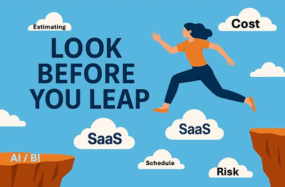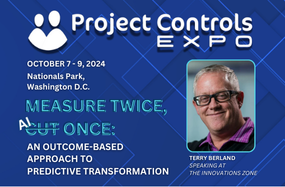
Choosing a Project Controls Cloud? Here’s the Real Question to Ask

Choosing a Project Controls Cloud? Here’s the Real Question to Ask
In construction, energy, and infrastructure, margins are thin and overruns are costly. With global capital projects running on average 20% over schedule and 80% over budget (McKinsey), project leaders can’t afford fragmented systems.
Most already trust proven tools: Primavera P6 for scheduling, Procore for field collaboration, Autodesk for design, and EcoSys for cost. The tools themselves aren’t the issue. The real question is simpler — and far more urgent:
How do you make these tools work together so your schedules, budgets, and risks don’t drift apart?
It’s not the software that derails performance, it’s the gaps between them. Misaligned systems create blind spots, delays, and cost overruns that no single hosting choice — on-prem, vendor cloud, or hyperscaler — can solve.
Related reading: Unlock Your Project Success through Data Centricity and Application Integration.
The Hidden Cost of Fragmented Choices
Project leaders today face a variety of hosting models: vendor clouds (Procore, Autodesk Construction Cloud), enterprise platforms (Oracle, SAP), and hyperscalers (AWS, Azure).
Each has appeal: Vendor clouds feel lightweight. On-premises feel safe. Hyperscalers promise scale. But none of these choices resolve the central issue: fragmentation.
Here’s what typically happens instead:
- Data silos multiply. Schedules in P6, costs in EcoSys, designs in Autodesk, field data in Procore. Each is accessible but not connected.
- Visibility vanishes. Reports take weeks to compile, and by the time they’re shared, they’re outdated.
- Risks go unnoticed. Early warnings get buried, and overruns creep in.
- Confidence erodes.Conflicting numbers undermine trust with boards, owners, and investors.
We saw this recently with a Tier 1 contractor. They ran Primavera, EcoSys, and Autodesk independently. Reports took two weeks to reconcile. Risk signals were missed. The result? A £10M delay. The tools weren’t the issue. The lack of integration was.
That’s the hidden cost of fragmented project controls. Moving to a vendor cloud or modernising on-prem won’t prevent these failures. They only decide where tools live — not whether they deliver performance.
Related reading: The Hidden Problem with Hybrid Cloud.
Why Cloud Alone Doesn’t Deliver Control
At first glance, today’s options look modern. Vendor ecosystems offer bundled apps. Hyperscalers provide raw infrastructure. On-premises keeps tools close.
But here’s the reality:
- Vendor clouds give you visibility only within their own walls — not across your entire portfolio.
- Hyperscalers leave your team to knit everything together, a burden that rarely pays off.
- On-premises feels secure, but without integration, decisions lag behind reality.
The outcome is predictable: leaders still can’t answer the basics with confidence. Are we really on budget? Where are we exposed to risk? Do numbers align across cost, schedule, and field?
The truth is simple: whether branded a “project management cloud” or traditional project controls software, location is not control. Only integration delivers that.
Related reading: From Dashboard to Command Centre.
The Case for a Unified Project Platform (UPP)
What project leaders really need isn’t another hosting model decision. They need a foundation that unifies cost, schedule, risk, and field data into one governed system.
That’s what a Unified Project Platform (UPP) delivers.
Instead of tools operating in silos, Primavera, Procore, Autodesk, and EcoSys become components of a single governed environment. That means:
- Unified access. One pane of glass across vendor-cloud, on-prem, and hosted applications.
- Consistent data. Real-time harmonisation gives leaders one version of the truth.
- AI-driven insights. With LoadSpring’s INSIGHTS™ solution, leaders ask questions in plain language — “Where are our risks this month?” — and receive immediate, reliable answers across systems.
- Governed collaboration. Contractors, owners, and internal teams work within one controlled ecosystem, reducing disputes and increasing accountability.
As Forrester VP and Principal Analyst Kate Leggett notes, “Industry clouds are going to be the preferred way that we buy software because of all the industry capabilities that are baked into them [so] you don’t have to start from scratch.” Forrester
The future of project delivery is not about choosing the “best” cloud. It’s about ensuring every system works toward one governed outcome.
Related reading: How a Capital Project Management System — Not Just Software — Solves Your Biggest Challenges.
The Future of Project Delivery
At the end of the day, project leaders aren’t buying vendor clouds, hyperscaler space, or connectivity.
They’re buying something far more valuable:
- Confidence that forecasts are reliable.
- Control over risks before they escalate.
- Performance that keeps projects on time and on budget.
The real question isn’t which cloud to choose. It’s this: Does your environment allow every tool to perform as one system of control?
That’s the promise of a Unified Project Platform — turning disconnected applications into one governed foundation for confident delivery.
Ready to move beyond fragmented tools and cloud debates?
See how a Unified Project Platform brings your project controls cloud to life — unifying cost, schedule, risk, and field data into one governed system.
Request a demo today and experience what real integration looks like.
Related Questions
What is cloud project management?
Cloud project management is the practice of running project workflows, data, and collaboration through cloud-hosted platforms.
What are examples of project controls?
Examples of project controls include cost management, schedule management, risk management, change management, and document control. These are the processes and tools used to plan, monitor, and control project performance.
What are the 5 project controls?
The five core project controls are:
- Cost control
- Schedule control
- Risk control
- Change control
- Scope control
What are project control systems?
Project control systems are the methods, processes, and software used to track and manage project performance. They provide frameworks for monitoring cost, schedule, scope, risk, and resources, ensuring projects stay on time and within budget.
What software do project managers use?
Project managers use a range of software depending on the industry and project type. In complex, capital projects, project managers rely on specialised applications to manage cost, schedule, design, and field activity. Common examples include Primavera P6 for scheduling, SAP for cost control, Autodesk for design and BIM, and Procore for site collaboration.








